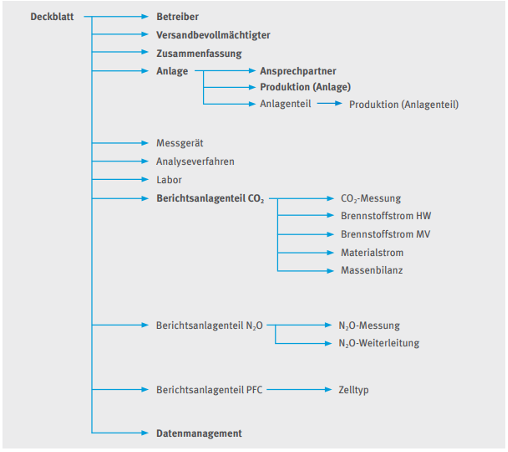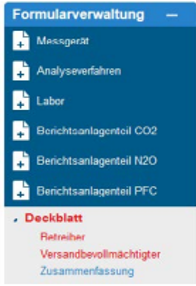In this article, we will look at the monitoring plan under the Fuel Emissions Trading Act (BEHG) and find out who is affected by it and what the requirements are. In addition, we will look at the DEHSt presentation of 04.07.2023 to get a comprehensive overview of the national emissions trading system (nEHS) in Germany.
Who is affected?
The Fuel Emissions Trading Act (BEHG) has an impact on biomethane taken from the natural gas grid. As of this year, biomethane is subject to national emissions trading. Obligated in the sense of the SESTA are also the distributors from January 1, 2023, where the energy tax for biomethane arises for the first time. As a rule, these are biomethane traders or BGAAs.
The Emission Reporting Ordinance (EBeV 2030) regulates the determination of emissions, reporting and verification under the SESTA from the year 2023 until the year 2030. It is important to note that fuel emissions from sustainable biomass can be applied with an emission factor of zero. However, this requires a separate verification of the sustainability of the biomass used.
What requirements result with regard to the monitoring plan under the Fuel Emissions Trading Act (SESTA)?
The reporting obligation under the SESTA basically relates to CO2 emissions from all energy sources regulated by the Energy Tax Act, including biomethane. However, fuel emissions from sustainable biomass can be assigned an emission factor of zero, which means that no emission allowances have to be surrendered for them.
In order to be able to use the zero emission factor for biogenic emissions in accordance with Section 8 (2) EBeV 2030, proof of the sustainability of the biomass used must be submitted to DEHSt. This proof must be provided along the supply chain and a mass balance must be kept. A prerequisite for recording and submitting the proof is certification along the supply chain.
Previously, only biomethane plants with at least 2 MW of combustion heat capacity were certified under the Biomass Electricity Sustainability Ordinance. Plants below this threshold whose biomethane is injected into the natural gas grid may now need to be certified. At this time, the functionality for transferring sustainability credentials from the BLE's Nabisy database has not yet been technically established. Until this is done, a transitional provision applies whereby electronic proof can be transmitted via a recognized certification system (e.g. SURE).
DEHSt presentation from 04.07.2023
DEHSt (German Emissions Trading Authority) conducted a presentation on the national emissions trading system (nEHS) in Germany, which serves as a package of measures to safeguard climate targets. It includes CO2 pricing for sectors outside the EU ETS. The BEHG provides the legal framework for the nEHS from 2021. DEHSt is responsible for the enforcement of the nEHS and the EU-ETS. The revenues from certificate trading flow into the Climate and Transformation Fund, which finances various climate protection measures as well as national and international climate protection projects.
Basic aspects of the monitoring plan
There is a simple OB, which is used if only default values according to Annex 2 EBeV 2030 are used. For other cases, there is the regular OB, which is used in particular for individual determination of calculation factors and fuel quantity determinations without reference to the energy tax filing. The monitoring plan ensures compliance of emission reporting, based on approved monitoring methods.
The monitoring plan forms the basis for the preparation of all emissions reports from 2024 onwards. It must be prepared for the trading period until 2030 by 31.10.2023 via the DEHSt platform using the electronic templates provided for this purpose (Forms Management System, FMS). The monitoring plan describes the monitoring methodology for calculating fuel emissions. In principle, the monitoring of emissions must be transparent, complete, comparable, consistent and accurate. New plants (are the plants that started operation after 29.02.2020) must submit the monitoring plan before the date when they are first subject to the obligations under Section 5 TEHG. This means that monitoring plans must be submitted not only by the time of commissioning, but already before the first emission of greenhouse gases. The monitoring plans and their signature must be submitted electronically via the Virtual Post Office (VPS).
Changes to the monitoring plan
A distinction must be made between significant and non-significant changes to the monitoring plan. This results in different notification obligations. Significant changes are, for example:
- Inclusion of material flows and emission sources not previously included in the monitoring plan
- Changing the applied level
- Change of monitoring method, for example from standard method to mass balance or from standard method to continuous emission measurement
- Change of measuring device, if the proof of compliance with the required level changes (except replacement of a measuring device with a calibrated measuring device)
- Change of a laboratory (except change to a laboratory accredited according to DIN EN ISO/IEC 17025)
In the event of a significant change, the monitoring plan shall be adjusted without delay.
Non-significant changes are changes that serve to correct what was previously already described in the monitoring plan and all other exceptions to the above significant changes. These include, for example:
- Changes of address, change of contact person for the facility or changes of responsibilities within the facility.
- Capacity change of an installation without change of the emission permit and without inclusion of new emission sources or substance streams, change of installation components or technologies used in the installation, change of installation category or classification of substance streams, without having to comply with higher tier requirements according to MVO compared to the approved monitoring plan
- Change of the commissioned laboratory, provided that an accredited laboratory within the meaning of Art. 24 Para. 1 MVO is commissioned.
- Change in the collection of data by the supplier, if it is ensured by specifications in the monitoring plan that the specifications of the MVO are complied with and evidence of this is provided
All non-significant changes to the monitoring plan should be collected and reported to DEHSt together with the next significant change
Forms Management System (FMS)
The FMS enables users to efficiently create the monitoring plan. In addition to direct data entry, the system also supports the import of monitoring plans. Version management is also possible. The monitoring plan can additionally be set to two modes.
Read mode: In read mode, the information in the monitoring plan can only be read.
Edit mode: In edit mode, all functions for editing the monitoring plan are enabled.

Figure 1:
Structure of the forms in the FMS [5].
Figure 2:
Directory tree in FMS [5]

The forms marked in bold are always initially created in the monitoring plan. All other forms can be created by the plant operator as required. To be able to add forms, the higher-level form must be selected in the directory tree. For example, if a "Measuring device" form is to be created, the plant operator first selects the "Cover sheet" form. Thereupon, the possible forms that can be created appear above the directory tree (cf. Figure 2). Only forms that are required due to the plant constellation should be created. If a monitoring plan is to be submitted to DEHSt, then the file must be exported as a ZIP file. The file must then be forwarded to DEHSt via the VPS.
Virtual mailroom (VPS)
Electronic communication with DEHSt takes place via the Virtual Post Office (VPS). The VPS is a kind of electronic post office to which messages can be sent in a secure manner and from which incoming messages must be collected. The VPS ensures that really only the intended recipient can decrypt and read the message.
Signature
To send messages via the VPS, a signature card (SmartCard) with a valid qualified signature (QES) and a suitable card reader (SmartCardReader) are required.
Finally, it is worth mentioning that the DEHSt platform is used to communicate and submit monitoring plans and emissions reports. It is important to set up a compliance account in the nEHS registry to submit data. Data collection is done in the Forms Management System (FMS) and after the monitoring plan is created in the FMS, it is exported, uploaded and signed and submitted via the DEHSt platform.
Sources
[1] Welcome and introduction to the event program
[2] Create the monitoring plan in the Forms Management System (FMS).
[3] General introduction to emissions reporting and monitoring
[4] Electronic communication with the German Emissions Trading Authority
[5] Guidance on the preparation of monitoring plans and emission reports for stationary installations in the 4th trading period (2021 to 2030).
